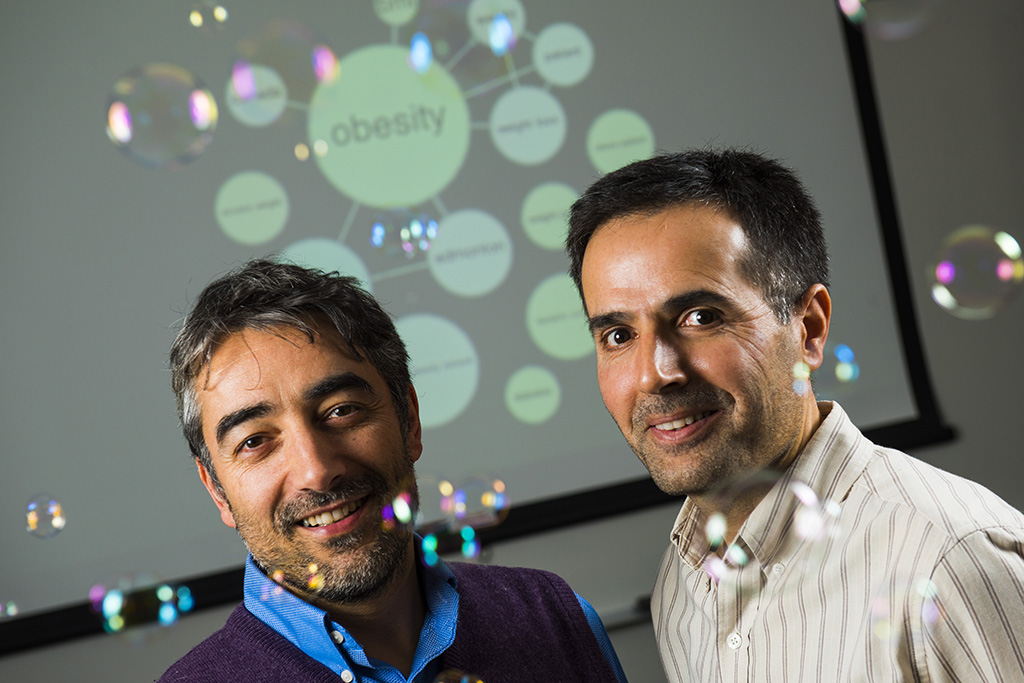
Computing scientists Osmar Zaiane and Davood Rafiei from the University of Alberta's Faculty of Science are breaking ground with BubbleNet, an innovative interface that can visually summarize entire subjects. Photo credit: John Ulan
Ready to discover what you never knew you wanted to learn? Computing scientists Davood Rafiei and Osmar Zaiane from the University of Alberta's Faculty of Science are breaking ground with BubbleNet, an innovative interface that can visually summarize entire subjects.
"BubbleNet allows the user to discover new knowledge about a certain subject that they may not have previously even been looking for," explains Zaiane, expert in machine learning and data mining, at the 2016 International Conference on Digital Economy.
Acting as a sort of digital librarian, BubbleNet is a visual force-directed graph that visually displays relevant keywords, topics, and relationships between ideas within a particular body of literature. The user can navigate the concepts (shown as bubbles), reach new concepts and filter using keywords. This allows the user to see the big picture concepts in a particular network of ideas, as well as to drill down to find more detailed information about a specific area with specific applications for health and health care.
One challenge BubbleNet hopes to address is helping patients and practitioners search for accurate and relevant information about health issues online.
Vocabulary mismatch
"One problem with searching health forums is that the user might not know the jargon or technical vocabulary to search for," explains Rafiei, expert in big data and information management. "For example, the medical term for a disease can be different than how it is commonly referred to among the general public. Known as vocabulary mismatch, this problem is common in domains where people use different terms or concepts to describe the same thing."
Another common problem when searching for health care information is the format of results. A search engine like Google will present results in a list form that misses the relationships between the results.
"BubbleNet solves these problems by filling the gaps where general search engines might fall short," explains Rafiei. "The visualization engine shows concepts and their relationships, providing a visual representation of ideas or concepts and the connections that exist between them and giving the user key information at a glance."
"Our research shows that users preferred BubbleNet for exploratory search over keyword-based searches, like Google. BubbleNet was also faster, satisfying the user information needs in much less time," says Zaiane.
Endless possibilities
And best of all? The applications for BubbleNet are almost limitless.
"From cybersecurity to health care, there are many, many ways for BubbleNet to be of use," says Rafiei.
Adds Zaiane, "Another critical question we hope to address is: what health information can be trusted? We are incorporating BubbleNet into another project called Cardea. Cardea is a health portal for patients and medics that helps to address the question of trustworthiness of health information."
The project started when Zaiane's colleague, Arya Sharma, obesity expert with the Faculty of Medicine and Dentistry, was searching for a way to better index and search within his popular obesity blog.
"Based on our past experience building and querying complicated interfaces, Saeed Mohajeri, an MSc alumnus, devised this visualization tool that summarizes the content and allows interactive navigation of text content," explains Rafiei.
Mohajeri is now working at Facebook. BubbleNet is used within another project by Zaiane's PhD student, Hamman Samuel. Both Rafiei and Zaiane are working on related topics including indexing and mining text and information querying and visualization.